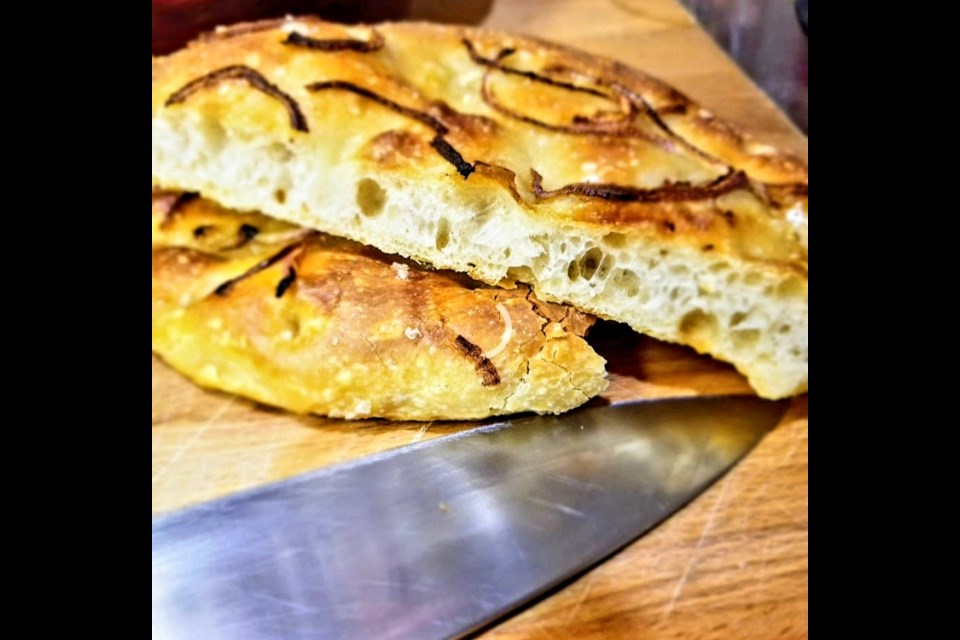Focaccia, a simple Italian flat bread flavoured with salt, olive oil, herbs or other seasonal toppings, is a delicious bread that can be found all over the world. Known as fougasse in France and hogaza in Spain, many other countries also have their take on this type of simple bread.
The word focaccia derives from the Roman “panis focacius” which translates into hearth bread. Going back to the Etruscans age; flour, salt, yeast and water created a simple, free-form, flatbread that could be simply baked amongst the coals of the fire. It was quick and much easier than traditional breads. An early, “quick bread," although there is still a rise time.
Although the Liguria region of Italy in the north west is where the recipe is said to have originated, each region of Italy has adapted it as their own depending on what ingredients are most available.
Genoa, a famous ship-building city, located in Liguria, on the north west coast, is where the simplest version can be found. Focaccia Genovese is known for its characteristic deep dimples and moistness from the “salamoia”; a solution of salt, olive oil and water that is brushed on the focaccia to add the salty flavour and ensure moistness.
I have also had focaccia in this region with thinly sliced onions which become much milder when the bread is baked. My tip: if you coat the onions in olive oil before baking, they won’t burn.
Further south, still on the west side of the peninsula in Tuscany, they typically will make their version of focaccia with salt and fresh rosemary sprigs. There is even a sweet and savoury version known as “schiacciata all’uva” made during the wine season topped with leftover grapes, salt and rosemary. A little unexpected and quite delicious (coating the rosemary with olive oil also prevents burning).
In the southern region of Puglia, the delicious focaccia barese can be found. Typically a moist flat bread with the signature divots, salt and extra virgin olive oil, but also with the addition of fresh tomatoes on top. In some places, tomatoes and olives with the pits are included. Like many regional specialties, there is a controversy over which dough is best.
Some incorporate mashed, boiled potatoes or even potato flakes in the dough to create a moist crumb. Others use the traditional flour, water, salt and yeast only. A well oiled, cast iron pan creates this lovely crust on the bottom that is almost fried. No wonder it’s my favourite!
Focaccia is all typically sold by weight at the bakery in Italy, by the slice. Usually three to four centimetres thick, it can also be sliced crosswise and used for a sandwich. My favourite would be porchetta on focaccia found at a street vendor in a bustling market like Campo de Fiori in Rome. Just look for the longest line of locals when trying to find one.
Here in North America there are a lot of breads that are synonymous with flatbreads, rather than focaccia. They must be the proper thickness, moist, with or without the dimples but most importantly the salt and olive oil. Simple herbs, tomatoes, onions or olives. Any other toppings may be considered pizza bianca or white pizza.
In Guelph, you can find artisanal focaccia at Polestar Hearth on Woolwich Street. They produce two varieties, available on Thursdays after 11:30 a.m. Kitchen manager Toby Deys makes the sourdough (natural yeast), focaccia dough from scratch. She prepares a classic rosemary focaccia and another, special, seasonal variety which changes weekly. It regularly sells out so get them early.
Polestar Hearth has implemented a unique window system since the spring of 2020 to protect customers and their eight person staff from covid-19. Heather Groot, front of house manager, explained this timely, walk through system to me one day last week. This totally contact-free system is a win/win!
Polestar Hearth is closed for vacation until Aug. 11.



